22.06.2020
Weather looks OK for next SpaceX Starlink launch from Cape Canaveral
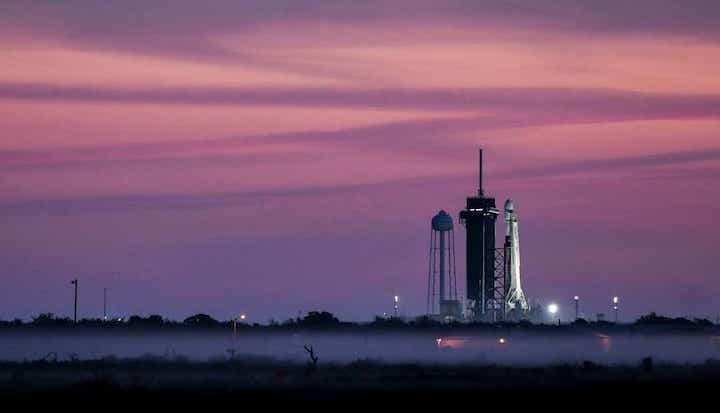
The weather forecast appears to be trending slightly toward favorable conditions for the Space Coast's next launch from Kennedy Space Center.
If schedules hold, a SpaceX Falcon 9 rocket will likely encounter 60% "go" conditions for its 5:58 p.m. Tuesday liftoff from pad 39A, the Space Force's 45th Weather Squadron said Saturday. The 230-foot rocket will carry about 60 Starlink satellites for the company's tenth internet constellation mission.
Showers and thunderstorms are expected Tuesday but should move mostly inland just before the launch time.
"But westerly winds in the mid and upper levels will cause some of them and their associated anvils to move back towards the east coast," forecasters said, noting that their primary concerns are large cumulus clouds, anvil clouds, and the possibility of lightning.
Along with just under 60 Starlink satellites, Falcon 9 will also take two spacecraft for BlackSky, a Seattle-based Earth imaging company. If successful, the Starlink constellation will grow to almost 600 low-Earth orbit spacecraft, continuing SpaceX's march toward delivering high-speed internet from space.
After liftoff, the 162-foot first stage is expected to land on a drone ship hundreds of miles off the east coast of Florida before returning to Port Canaveral a couple days later.
Contact Emre Kelly at aekelly@floridatoday.com or 321-242-3715. Follow him on Twitter, Facebook and Instagram at @EmreKelly. Support his space journalism by subscribing at floridatoday.com/specialoffer/.
Launch is Tuesday
- Rocket: SpaceX Falcon 9
- Mission: About 60 Starlink satellites
- Launch time: 5:58 p.m. ET
- Launch pad: 39A at Kennedy Space Center
- Landing: Drone ship
Quelle: Florida Today
+++
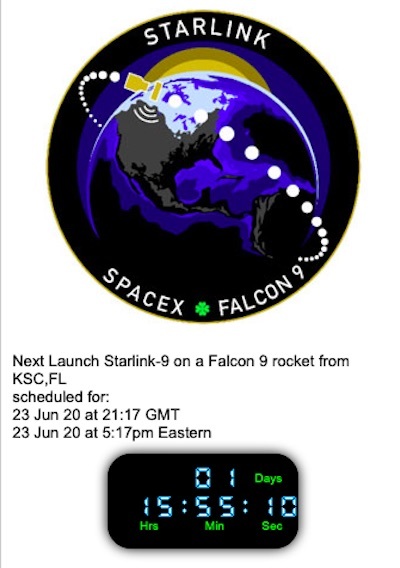
----
Update: 23.06.2020
.
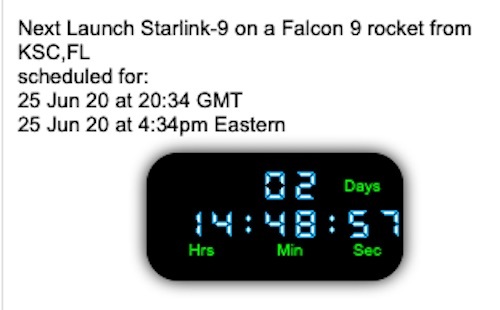
+++
SpaceX Starlink launch delay inches closer to worsening weather
Rocket launch fans will have to wait another two days to see SpaceX's Falcon 9 rocket soar over Space Coast skies carrying another 60 Starlink satellites. The launch is now slated for Thursday at 4:39 p.m. from pad 39A at Kennedy Space Center.
Unfortunately, the delay moves the launch closer to worsening weather. The 45th Space Wing weather squadron predicts a 40% "go" for Thursday. Primary concerns are large cumulus clouds, anvil clouds, and the possibility of lightning. Conditions are marginally better on Friday.
In an effort to fund his ambitious goal of reaching Mars, SpaceX CEO Elon Musk is jumping into the broadband internet business with his Starlink satellite constellation. The satellites will provide internet connectivity from space to rural areas. Musk has said he hopes to begin service to customers in parts of North America near the end of the year.
If Thursday's tenth Starlink launch is successful, the constellation will number around 600 satellites in orbit.
Although not fully operational yet, you can apply to be a beta-tester at the Starlink website. According to Starlink, "private beta testing is expected to begin later this summer, followed by public beta testing, starting with higher latitudes."
In addition to the Starlink payload, two Earth observation microsatellites from Seattle-based BlackSky are also hitching a ride on the Falcon 9 as part of the SpaceX rideshare program which offers a lower cost option for aerospace companies to reach orbit.
Quelle: Florida Today
----
Update: 25.06.2020
.
SpaceX gearing up for another launch of Starlink broadband satellites this week
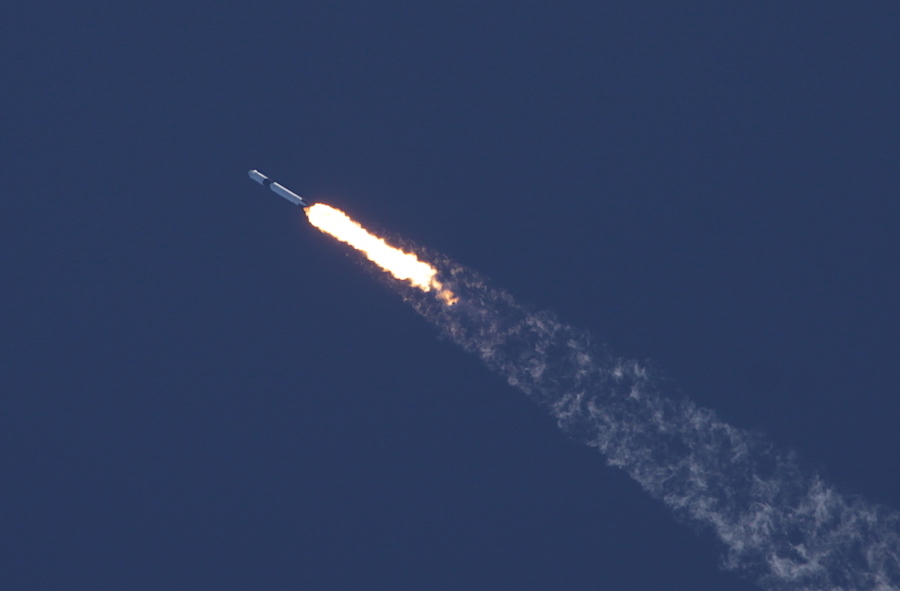
For the third time in three weeks, SpaceX is preparing to launch a batch of satellites for the company’s Starlink Internet network from Florida’s Space Coast. Liftoff of a Falcon 9 rocket is set for Thursday afternoon from pad 39A at NASA’s Kennedy Space Center in Florida, weather permitting.
Liftoff of SpaceX’s Falcon 9 rocket is scheduled for Thursday at 4:39 p.m. EDT (2039 GMT), and two commercial Earth-imaging microsatellites owned by BlackSky will accompany the Starlink payloads into orbit.
The launch Thursday will be SpaceX’s fourth Falcon 9 mission in less than four weeks, continuing a whirlwind cadence of launches that began May 30 with the liftoff of SpaceX’s Crew Dragon spacecraft carrying NASA astronauts Doug Hurley and Bob Behnken into orbit.
SpaceX launched another Falcon 9 rocket June 3 with 60 Starlink satellites, and most recently delivered another 58 Starlink payloads into orbit with a Falcon 9 rocket June 13 on a flight that also carried three commercial SkySat Earth-imaging satellites to space for Planet.
Thursday’s mission will be SpaceX’s 11th launch of 2020, and will be followed by another Falcon 9 launch scheduled June 30 from pad 40 at Cape Canaveral Air Force Station with the U.S. Space Force’s next GPS navigation satellite.
The launch June 30 is scheduled for a 15-minute window opening at 3:55 p.m. EDT (1955 GMT).
SpaceX plans to test-fire the rockets for its next two missions this week. The previously-flown Falcon 9 rocket assigned to the Starlink/BlackSky launch is scheduled for a hold-down test-firing of its nine Merlin main engines Wednesday at pad 39A.
A test-firing of the brand new Falcon 9 booster for the GPS launch is scheduled later this week on pad 40, perhaps as soon as Thursday.
Forecasters predict typical summertime weather on Florida’s Space Coast for Thursday afternoon. There’s a 60 percent chance weather conditions could violate the Falcon 9’s liftoff weather constraints at launch time Thursday, according to an outlook issued Tuesday by the Space Force’s 45th Weather Squadron.
The weather pattern over the next several days on the Space Coast “will favor afternoon showers and thunderstorms with daytime heating and the prevailing offshore flow,” forecasters wrote Tuesday. “The east coast sea breeze will remain closer to the coast, and the west coast sea breeze will move across the peninsula. Mid to upper level westerly steering flow will also help push showers and storms, along with their associated anvils, back towards the east coast.”
The main weather concerns for Thursday’s launch opportunity will be with the potential for violating the cumulus cloud, anvil cloud and lightning rules.
There’s some slight improvement in the forecast for a backup launch opportunity Friday afternoon, when there’s a 40 percent chance of weather violating launch criteria.
SpaceX’s Starlink network is designed to provide low-latency, high-speed Internet service around the world. SpaceX has launched 538 flat-panel Starlink spacecraft since beginning full-scale deployment of the orbital network in May 2019, making the company the owner of the world’s largest fleet of satellites.
SpaceX says it needs 24 launches to provide Starlink Internet coverage over nearly all of the populated world, and 12 launches could enable coverage of higher latitude regions, such as Canada and the northern United States.
The Falcon 9 can loft up to 60 Starlink satellites — each weighing about a quarter-ton — on a single Falcon 9 launch. But launches with secondary payloads, such as BlackSky’s new Earth-imaging satellites, can carry fewer Starlinks to allow the rideshare passengers room to fit on the rocket.
The initial phase of the Starlink network will number 1,584 satellites, according to SpaceX’s regulatory filings with the Federal Communications Commission. But SpaceX plans launch thousands more satellites, depending on market demand, and the company has regulatory approval from the FCC to operate up to 12,000 Starlink relay nodes in low Earth orbit.
Elon Musk, SpaceX’s founder and CEO, says the Starlink network could earn revenue to fund the company’s ambition for interplanetary space travel, and eventually establish a human settlement on Mars.
Quelle: SN
+++
Update: 19.30 MESZ
.
SpaceX to Launch 10th Batch of Starlinks, Pair of Rideshare Satellites on Friday
Four weeks since the triumphant ride to orbit of Dragon Endeavour crewmen Doug Hurley and Bob Behnken, the Kennedy Space Center’s (KSC) historic Pad 39A will reverberate again to the roar Merlin 1D+ engines as early as 4:18 p.m. EDT on Friday, 26 June, to deliver dozens of small satellites into low-Earth orbit. Aboard the Falcon 9—which will utilize the flight-proven B1051 core, marking the third occasion in three months that a booster has flown a fifth time—are SpaceX’s tenth dedicated batch of Starlink satellites and a pair of Earth-observation satellites provided by Herndon, Va.-based Spaceflight Industries, Inc for their customer BlackSky.
It comes only days after Spaceflight announced a major new contract with SpaceX “to secure rideshare capacity on multiple launches” through late 2021.
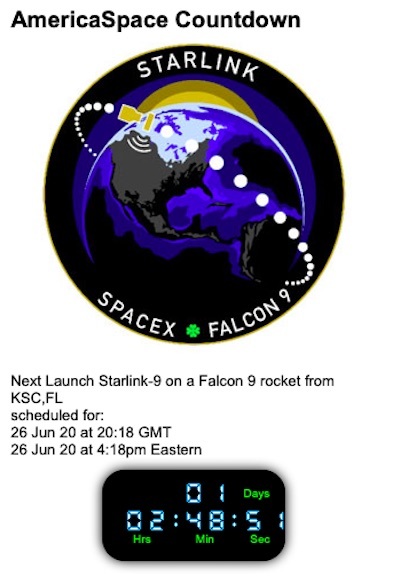
Quelle: AS
+++
SpaceX Starlink launch pushes another 24 hours
UPDATE: This SpaceX Starlink satellite launch is now slated to liftoff from Kennedy Space Center Friday June 26 at 4:18 p.m.
When a SpaceX Falcon 9 rocket launches from Kennedy Space Center Thursday late afternoon, it'll officially push the company's Starlink efforts into the double digits and act as a reminder that multitudes more are still on the way.
Slated for a 4:39 p.m. liftoff from pad 39A, the tenth launch of roughly 60 internet-beaming Starlink satellites will push the constellation's size to nearly 600 in low-Earth orbit. Weather for the 10-minute window is expected to be 40% "go," according to the Space Force.
After liftoff, the rocket's 162-foot first stage will target an automated drone ship landing in the Atlantic Ocean. It should return to Port Canaveral for checkouts and refurbishment a few days later.
Thursday's launch is yet another in SpaceX's 2020 cadence, which to date has produced 10 total launches. If schedules hold, the Space Coast could see at least that many more before the year is out thanks to a combination of Starlink, commercial, and military missions.
With this tenth launch of Starlink, SpaceX appears to be inching ever closer to its goal of opening up broadband services on the ground. Private beta testing is expected to open this summer for users such as early investors, while a public beta should begin this fall for those in the higher latitudes of North America.
To access the constellation, users just need a pizza box-sized, circular antenna known as a ground terminal.
"Just two instructions for Starlink: plug in and point at sky," SpaceX CEO Elon Musk said via Twitter last week. "Can be done in either order."
Internet access via satellite isn't new. For decades, various companies, including Microsoft-supported Teledesic in the late 1990s, have attempted to monetize the potential for anyone in any location on Earth to use broadband internet, but most have failed. Some were smaller spacecraft in low orbit, while others have been larger satellites thousands of miles above Earth.
But the distance of those geostationary satellites means the delay between asking for a data transfer and it actually occurring – known as latency – is a real challenge. Measured in milliseconds, the average terrestrial internet user can expect somewhere under 100ms to be sufficient. Most in-home service these days can deliver 50ms or less, according to internet infrastructure company Cloudflare.
One of Starlink's advantages is that its satellites sit roughly 340 miles above Earth, a distance that allows SpaceX to reduce latency. CEO Elon Musk expects current performance at around 20ms.
"It’s designed to run real-time, competitive video games," he said last week. "Version 2, which is at lower altitude, could be as low as 8ms latency."
During previous conferences with reporters, Musk has emphasized that SpaceX doesn't need to have tens of thousands of satellites in orbit to start effectively delivering service – it could begin with as few as 1,000. Having more in orbit affords the ability to attract more customers from different regions, as well as improve performance in areas already being served.
In regulatory filings, the company has said it could launch as many as 40,000 of the flat spacecraft, though that remains to be seen. As it stands, SpaceX will likely consistently launch Starlink missions for the foreseeable future.
Quelle: Florida Today
----
Update: 26.06.2020
.
SpaceX Starlink launch targeting Friday afternoon launch
A dramatic week on the Space Coast that included lightning storms, a surge in COVID cases and a massive drug bust might be capped with a rocket launch if weather holds.
After being postponed a couple times this week, SpaceX is now targeting Friday afternoon at 4:18 p.m. to launch its tenth batch of Starlink satellites aboard a Falcon 9 rocket from pad 39 A at Kennedy Space Center.
The delay has increased the chances for better weather. The 45th Space Wing's weather squadron now predicts a 70% "go" for launch on Friday afternoon up from 40% Thursday. As is the case with most afternoons during the Florida summer, the main concerns are large cumulus clouds, anvil clouds, and the possibility of lightning.
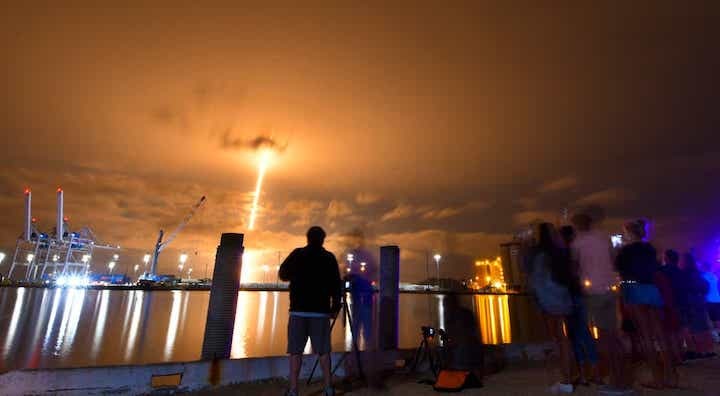
Friday's launch of the 57 satellites is part of SpaceX's plan to offer broadband internet services from space. If all goes well, the constellation will number around 600 satellites in orbit after this launch. SpaceX hopes to begin offering the internet services to rural areas later this year.
In addition to the Starlink payload, two Earth observation micro-satellites from Seattle-based BlackSky are also hitching a ride on the Falcon 9 as part of the SpaceX rideshare program which offers a lower cost option for aerospace companies to reach orbit.
But that's not all: there's another Falcon getting ready to fly. Nearby at launch complex 40 on Cape Canaveral Air Force Station, SpaceX is prepping for the launch of the Space Force's GPS III satellite early next week.
Launch Friday
- Rocket: SpaceX Falcon 9
- Mission: 57 Starlink satellites
- Launch time: 4:18 p.m. ET
- Launch pad: 39A at Kennedy Space Center
- Landing: Drone ship
Quelle: Florida Today
+++
Update: 22.00 MESZ
.
Jun 29 - Falcon 9 : Starlink-9 Launch site KSC,FL
Launch Date Jun 29
From Launch Pad LC-39A
Launch Window : Estimated 4:15pm Eastern (20:15 GMT)
A Falcon 9 rocket will launch from Launch Complex LC-39A at Cape Canaveral Air Force Station carrying the 9th batch of Starlink communications satellites. Also onboard are 2 satellites from BlackSky, a Spaceflight customer.
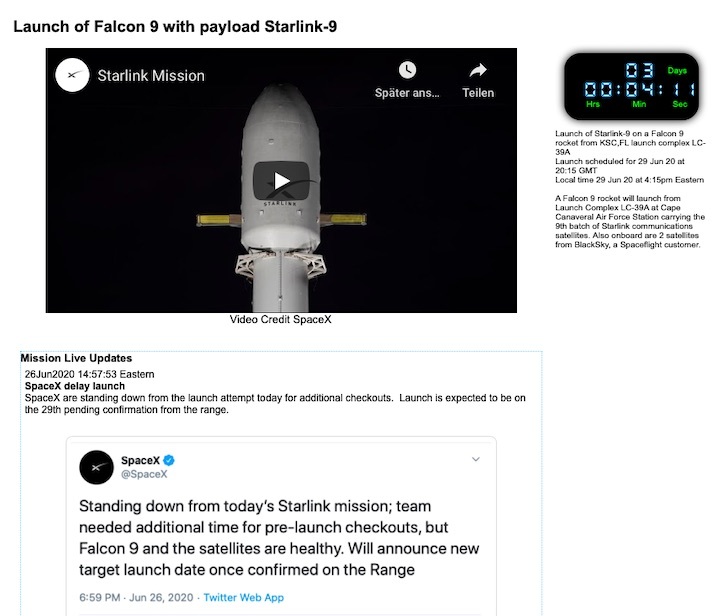
Quelle: AS
----
Update: 6.07.2020
.
Weather looks good for SpaceX's next Starlink launch from Kennedy Space Center
The weather forecast looks mostly favorable for the Space Coast's next launch, a mission slated to see a 230-foot SpaceX Falcon 9 rocket take flight from Kennedy Space Center on Wednesday.
Conditions are shaping up to be 70% "go" for the 11:59 a.m. liftoff from pad 39A, the Space Force said Sunday, thanks to the movement of drier air. Teams will have until 12:05 p.m. to launch.
"On Wednesday, some drier mid-level air will likely move into the area, helping to limit shower and storm coverage compared to earlier in the week," the 45th Weather Squadron said. "The primary concern for the launch window is the cumulus cloud rule."
In the event of a technical or weather-related delay to Thursday, the forecast appears to remain roughly the same.
Packed into the rocket's payload fairing will be just under 60 Starlink satellites, part of the company's effort to deliver broadband internet service from low-Earth orbit. After liftoff and separation, the flat-packed satellites will raise their orbits to some 350 miles above Earth over the next several weeks.
Wednesday's launch will mark SpaceX's 10th mission for Starlink, pushing the constellation's size to just under 600 satellites.
Starlink missions normally fly with 60 spacecraft, but Wednesday's flight includes two "rideshare" satellites for BlackSky Global, a Seattle-based Earth monitoring company. Its constellation is mainly designed to provide high-resolution images for customers.
After liftoff from pad 39A, the Falcon 9 rocket's first stage will target a landing on the Of Course I Still Love You drone ship in the Atlantic Ocean. Its sibling, Just Read the Instructions, returned to Port Canaveral over the weekend after SpaceX's last launch – a Global Positioning System satellite – on June 30.
Of Course I Still Love You should arrive back on the Space Coast for the booster's post-launch checkouts and refurbishment by the end of the weekend.
Launch Wednesday
- Rocket: SpaceX Falcon 9
- Mission: About 60 Starlink satellites
- Launch time: 11:59 a.m. ET
- Launch pad: 39A at Kennedy Space Center
- Landing: Drone ship
Quelle: Florida Today
----
Update: 8.07.2020 / 7.25 MESZ
.
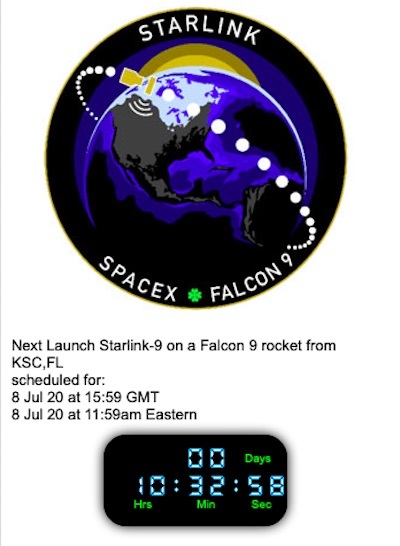
+++
19.00 MESZ
How to watch SpaceX's next Starlink launch from Kennedy Space Center
Update: Wednesday's launch attempt was scrubbed due to weather. Stay tuned for an updated launch date, which is currently no earlier than Friday.
SpaceX teams at Kennedy Space Center are set for the company's next launch on Wednesday, this time with 57 Starlink satellites bound for low-Earth orbit.
A Falcon 9 rocket is targeting 11:59 a.m. for the liftoff from pad 39A, followed by a landing on the Of Course I Still Love You drone ship shortly thereafter. Weather for the attempt, according to the Space Force, is 70% "go."
If successful, this tenth Starlink launch will boost the internet-beaming constellation's size to nearly 600 satellites.
There are two parts to our coverage on Wednesday:
► 10:30 a.m.: Live chat with our space reporters at floridatoday.com/space. We'll have in-depth discussions and you can ask us questions through launch and spacecraft separation.
► 11:30 a.m.: Real-time augmented reality and live video will be available in our 321 Launch app. You'll be able to follow live on your Android or iOS device in AR.
Remember: launch is at 11:59 a.m. ET. See you then.
Quelle: Florida Today
----
Update: 9.07.2020
.
Weather forces scrub of SpaceX Starlink launch from Kennedy Space Center
Update: Wednesday's launch was scrubbed due to weather conditions above pad 39A. The next attempt is expected around 11 a.m. Saturday, July 11.
The weather forecast looks mostly favorable for the Space Coast's next launch, a mission slated to see a 230-foot SpaceX Falcon 9 rocket take flight from Kennedy Space Center on Wednesday.
Conditions are shaping up to be 70% "go" for the 11:59 a.m. liftoff from pad 39A, the Space Force said Sunday, thanks to the movement of drier air. Teams will have until 12:05 p.m. to launch.
"On Wednesday, some drier mid-level air will likely move into the area, helping to limit shower and storm coverage compared to earlier in the week," the 45th Weather Squadron said. "The primary concern for the launch window is the cumulus cloud rule."
In the event of a technical or weather-related delay to Thursday, the forecast appears to remain roughly the same.
Packed into the rocket's payload fairing will be just under 60 Starlink satellites, part of the company's effort to deliver broadband internet service from low-Earth orbit. After liftoff and separation, the flat-packed satellites will raise their orbits to some 350 miles above Earth over the next several weeks.
Wednesday's launch will mark SpaceX's 10th mission for Starlink, pushing the constellation's size to just under 600 satellites.
Starlink missions normally fly with 60 spacecraft, but Wednesday's flight includes two "rideshare" satellites for BlackSky Global, a Seattle-based Earth monitoring company. Its constellation is mainly designed to provide high-resolution images for customers.
After liftoff from pad 39A, the Falcon 9 rocket's first stage will target a landing on the Of Course I Still Love You drone ship in the Atlantic Ocean. Its sibling, Just Read the Instructions, returned to Port Canaveral over the weekend after SpaceX's last launch – a Global Positioning System satellite – on June 30.
Of Course I Still Love You should arrive back on the Space Coast for the booster's post-launch checkouts and refurbishment by the end of the weekend.
Quelle: Florida Today
----
Update: 11.07.2020
.
SpaceX Starlink launch from Kennedy Space Center scrubs again; no backup date set
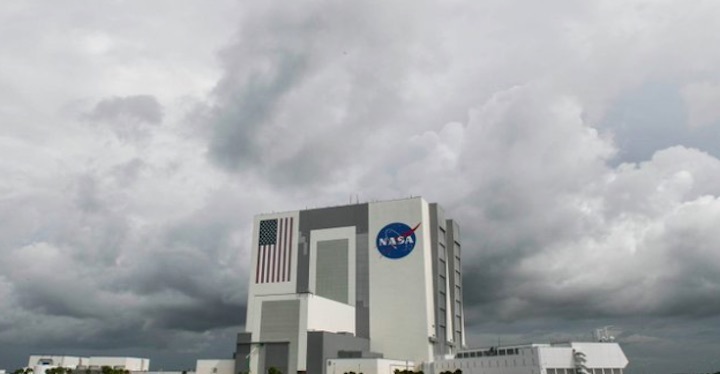
It just doesn't seem to be in the cards for SpaceX's launch of the tenth batch of Starlink internet satellites.
The company pulled the plug on a 10:54 a.m. Saturday liftoff from pad 39A at Kennedy Space Center, a mission that would have flown a 230-foot Falcon 9 rocket. It was the third scrub in two weeks.
SpaceX said the delay gives teams more time for hardware-related checkouts and preparations. A combination of hardware issues and inclement weather has pushed the launch date well past its initial launch window in late June.
The first attempt was delayed due to a need for more "pre-launch checkouts," and the second attempt on July 8 was scrubbed just before the window opening due to weather conditions around pad 39A.
There is currently no date set for the next attempt, but space lovers won't have to wait long for more rocket action. SpaceX is prepping another Falcon 9 to launch South Korea's first dedicated military satellite early next week from Cape Canaveral Air Force Station. That's currently slated for Tuesday afternoon.
Quelle: Florida Today
----
Update: 25.07.2020
.
SpaceX Starlink launch scheduled day before ULA NASA Mars mission
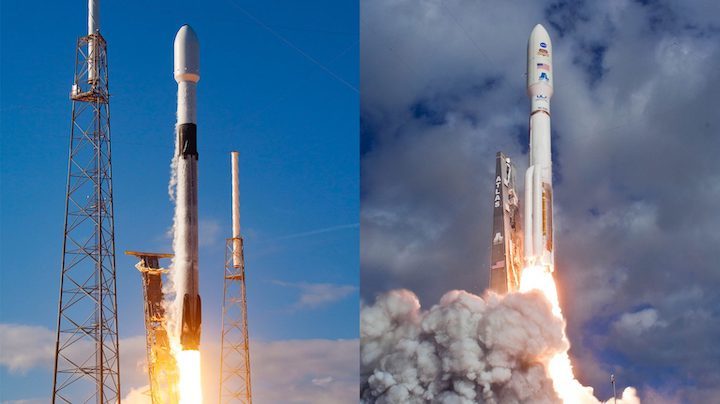
SpaceX’s 10th Starlink internet satellite mission could launch just a day before a ULA Atlas V rocket is scheduled to send NASA’s Mars 2020 ‘Perseverance’ rover on its way to Mars.
Following a full month of launch delays for SpaceX’s Starlink-9 mission and a bit less than two weeks of delays for ULA’s launch of NASA’s next Mars exploration mission, both missions have converged on the same ~24-hour period. Set be the third time SpaceX launches a single Falcon 9 booster on five orbital-class missions, Falcon 9 B1051 is scheduled to launch 57 Starlink v1.0 satellites and two BlackSky Earth imaging spacecraft no earlier than (NET) 4:26 am EDT (08:26 UTC) on Wednesday, July 29th.
Barring additional delays (arguably likely for both missions), a ULA Atlas V 541 rocket is then scheduled to launch NASA’s Mars 2020 Perseverance rover NET 7:50 am EDT (11:50 UTC) on Thursday, July 30th.
On July 8th, SpaceX got the closest yet to actually launching its tenth Starlink internet satellite mission but ultimately scrubbed just a handful of minutes before launch by stormy weather. Starlink-9 was later rescheduled to July 10th and then 11th but was indefinitely delayed shortly thereafter. Ironically, SpaceX was forced to steal Starlink-9’s Falcon 9 upper stage for use on the commercial ANASIS II satellite launch for South Korea after issues were discovered in the mission’s original hardware.
Falcon 9 booster B1058 and the former Starlink-9 upper stage successfully launched the ANASIS II military commsat on July 20th, breaking a world record for fastest orbital-class rocket turnaround(i.e. time between consecutive flights).
After a flight-ready upper stage already in Florida was presumably reassigned, SpaceX is once again ready to attempt to launch Starlink-9. In an unexpected twist, so long as the beleaguered mission can escape additional delays, the Starlink launch could come barely a day before the United Launch Alliance (ULA) is scheduled to send a NASA Mars rover on its way to the Red Planet. Currently scheduled to launch ~27 hours apart. If both missions avoid further delays, it would be one of the fastest back-to-back SpaceX-ULA launches ever, requiring close cooperation between both companies, NASA, and the US military’s 45th Space Wing.
Quelle: TESLARATI
----
Update: 31.07.2020
.
SpaceX Starlink mission nears third launch attempt after six weeks of delays
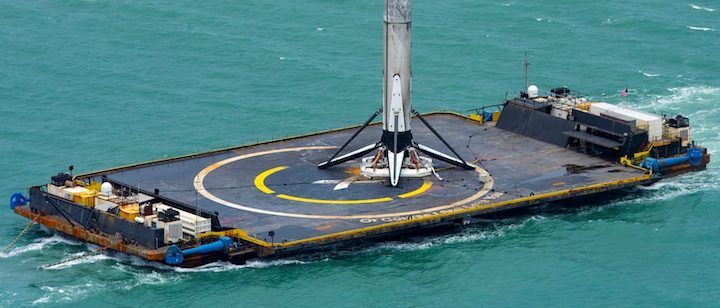
For the third time, SpaceX drone ship Of Course I Still Love You (OCISLY) has headed out to sea to support a booster landing attempt after the company’s tenth Starlink launch.
Known as Starlink-9, the mission will be SpaceX’s ninth launch of upgraded Starlink v1.0 satellites and the tenth dedicated internet satellite launch overall. For reasons known and unknown, Starlink-9 has been the most delayed SpaceX launch in recent memory, slipping from June 23 to the 25th and 26th and then from July 8th, 11th, 29th, and 31st. Almost six weeks of delays recently culminated (so far) with a 24-hour slip from July 31st. Starlink-9 is now scheduled to launch no earlier than (NET) 3:21 am EDT (07:21 UTC) on Saturday, August 1st.
As unlikely as it may seem in the context of more than a month of delays, if that schedule holds, Starlink-9 will launch less than 48 hours after a United Launch Alliance (ULA) Atlas V rocket is scheduled to send NASA’s newest Mars rover on its way to Mars. Prior to the last two slips, Starlink-9 and NASA’s Mars 2020 rover could have launched just 24 hours apart, give or take, but that ambitious schedule did not work out for unknown reasons.
Just like the first attempt last month, Falcon 9 booster B1051 is still assigned to Starlink-9 and will become the third SpaceX rocket to launch five times when it finally lifts off. Starlink-9 will be the second launch of SpaceX’s Smallsat Program, carrying two BlackSky Earth imaging spacecraft into orbit atop 57 Starlink v1.0 satellites.
The first Starlink rideshare was completed without issue on June 13th when Falcon 9 booster B1059 and a new upper stage helped place three Planet Skysats in orbit before deploying a stack of 58 Starlink satellites. Likely worth around $1 million per Skysat or BlackSky-sized satellite manifested, Starlink rideshares are a long shot from actually funding each launch but still represent significant savings when projected over the dozens to hundreds of Starlink launches SpaceX has planned.
According to SpaceX executives, 14 Starlink launches (~840 satellites) are needed before the company can seriously begin rolling out internet service to customers in the northern US and southern Canada. Several test programs are already underway in the form of private betas with SpaceX employees and families, while the first public beta tests could begin as early as next month.
As of now, SpaceX has completed nine Starlink launches since May 2019. Beginning in November 2019, eight of those nine launches have flown operational v1.0 satellites, meaning that SpaceX is likely six or so launches away from initial constellation operability. As of June 2020, it appeared that SpaceX could reach that milestone by the end of August, but Starlink-9’s unprecedented delays mean that the September/October time frame is now much more realistic target.
Quelle: TESLARATI
----
Update: 5.08.2020
.
Launch of Falcon 9 with payload Starlink-9
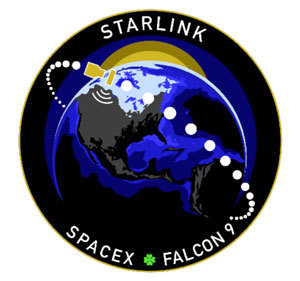
Mission Live Updates
Weather looks promising for Friday launch
The 45th Weather Squadron has released the L-3 day weather forecast for the Friday morning launch window. This predicts a 70% chance of acceptable conditions during the window. As is usual at this time of year the primary concerns are violation of the Thick Cloud Layer and Cumulus Cloud rules for Launch Commit Criteria.
Should the 24 hour turnaround window be required then the chances improve to 80% go with the sole concern being Cumulus Clouds.
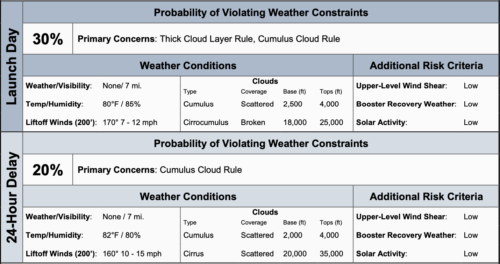
4Aug2020 11:43:03 Eastern
New launch day selected for Starlink 9
The Launch Date for the postponed Starlink-9 launch aboard a Falcon-9 rocket was expected to have been Thursday 6th August, but it looks to have slipped to early morning on Friday 8th. There is a short launch window extending from 1:07am to 1:18am.
11Jul2020 9:29:19 Eastern
Launch cancelled for today
SpaceX have just announced that they are standing down for today to allow for more pre-flight checks. They have not announced a new launch date yet.
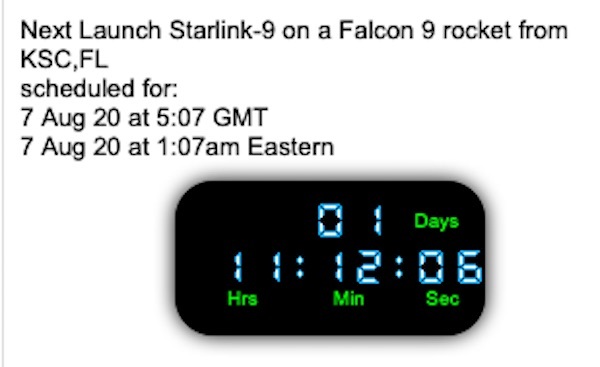
Weather OK for SpaceX's next Starlink launch from Kennedy Space Center
The weather forecast appears to be mostly favorable for SpaceX's next launch from Kennedy Space Center, the Space Force said Wednesday.
If schedules hold, conditions should be 70% "go" for the liftoff of 57 Starlink satellites from pad 39A, currently scheduled for 1:12 a.m. Friday. The Falcon 9 mission also includes two Earth observation satellites for Seattle-based BlackSky.
"The primary weather concern for launch day will be mid- and upper-level clouds streaming across the region from the south along with cumulus clouds over the nearshore waters," 45th Weather Squadron forecasters said Wednesday.
In the event of a 24-hour delay due to weather or technical issues, conditions are expected to slightly improve to 80% "go."
This 10th Starlink launch has been delayed nearly 10 times due to a spate of issues, primarily technical. After several attempts in June and July, the rocket was rolled back into its hangar at pad 39A for additional hardware work. This will be the booster's fifth flight.
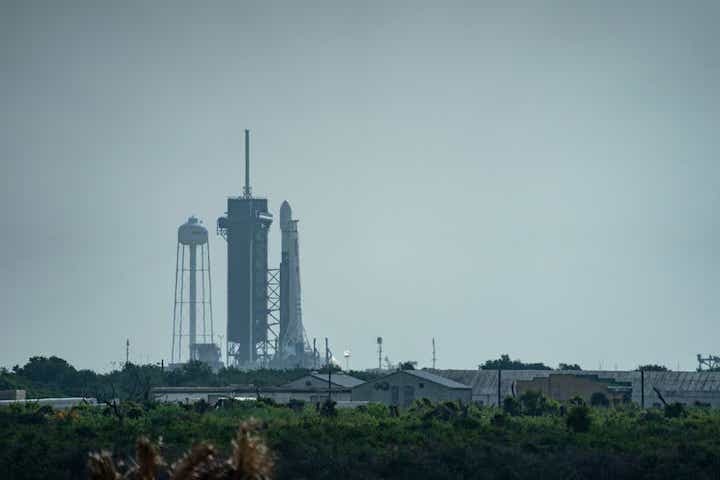
If deployment occurs as planned, the 57 Starlink satellites secured to the second stage will boost the constellation's size to nearly 600 in low-Earth orbit. The network is designed to bypass complicated ground infrastructure to deliver internet to poorly connected areas, though it will eventually be able to work worldwide regardless of coverage strength.
Thanks to Starlink's size and straightforward nature of just needing a small ground terminal, organizations such as the Air Force have seen the value in testing. Early stage investors have also been given terminals to test connectivity.
SpaceX is slated to begin public beta testing sometime later this year. CEO Elon Musk said speeds and latency have so far been on par with terrestrial internet, which is a significant improvement over legacy satellite internet. Other internet-beaming satellites often sit thousands of miles above Earth in geostationary orbit, meaning there's a delay between when information is requested and data transfers actually begin.
Though the company's Federal Communications Commission requests have fluctuated, SpaceX hopes to eventually have thousands of the spacecraft in low-Earth orbit for even worldwide coverage.
Quelle: Florida Today
----
Update: 7.08.2020 / 8.00MESZ
.
Start von SpaceX-Falcon 9 mit Starlink9 Satelliten Mission
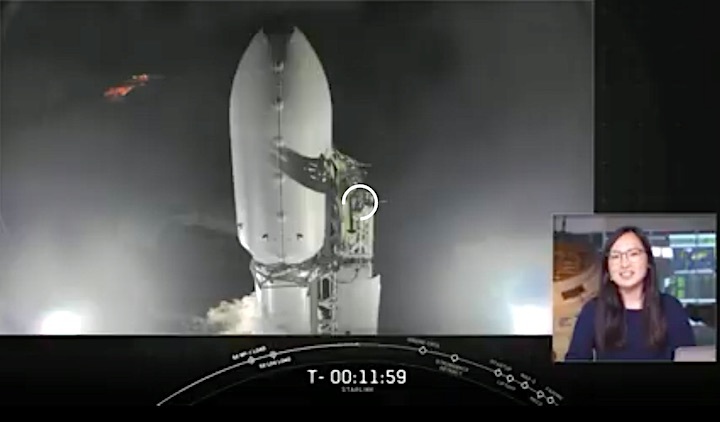
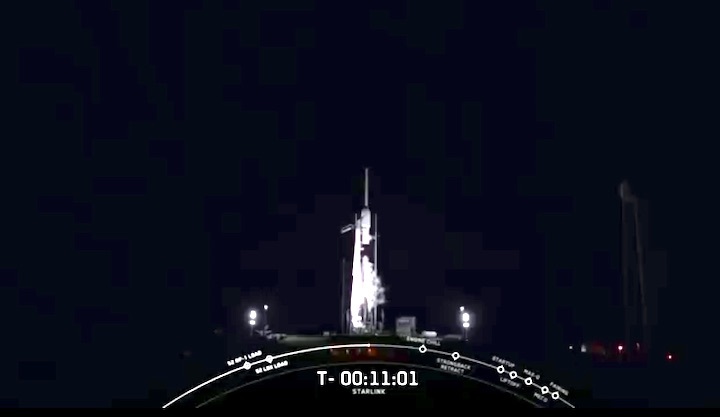
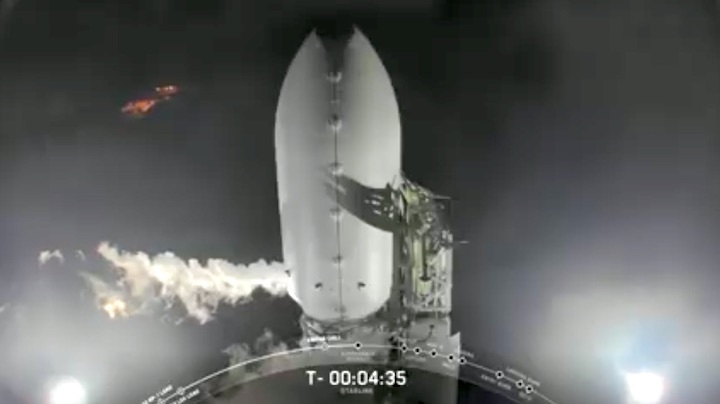
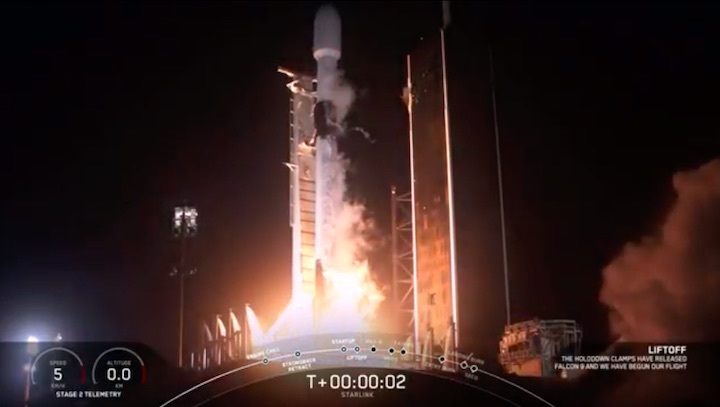
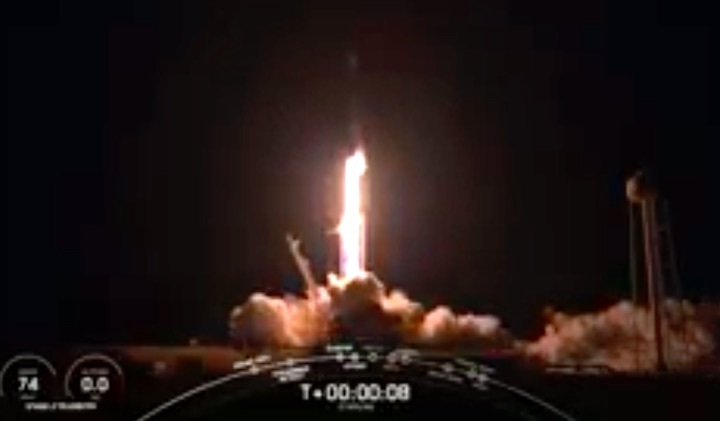
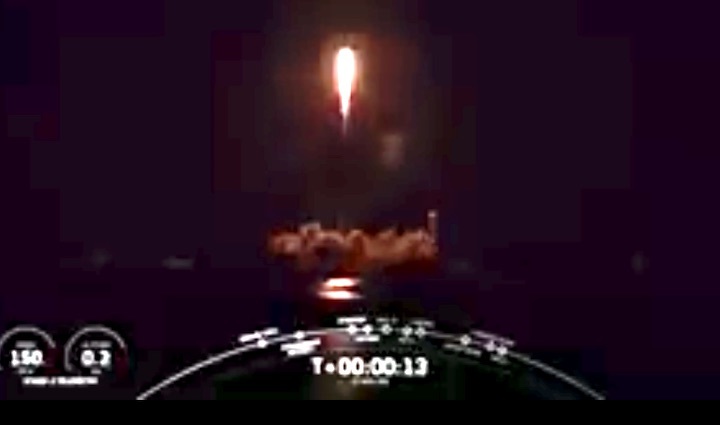
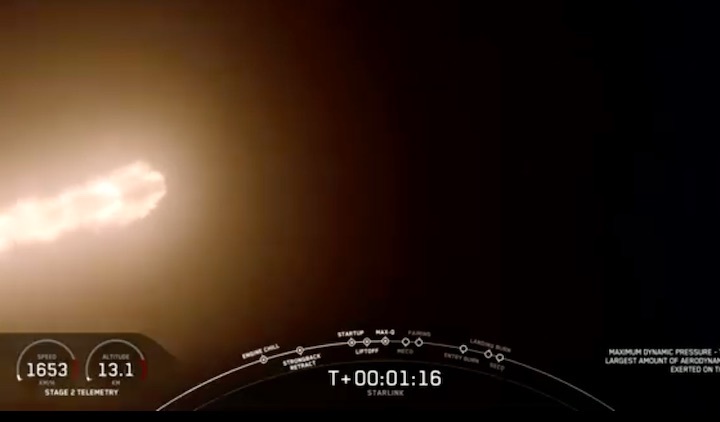
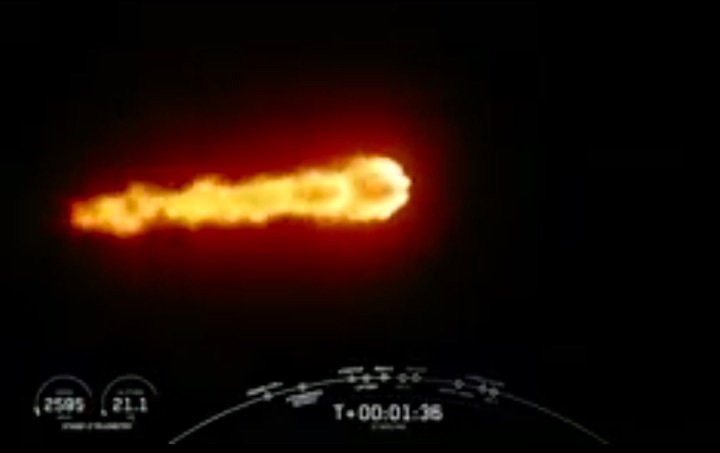
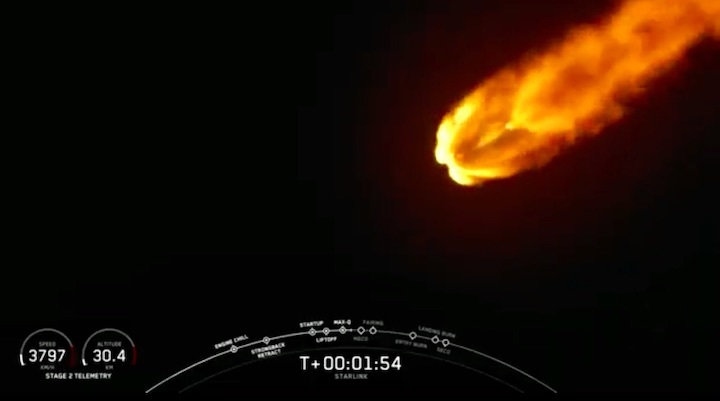
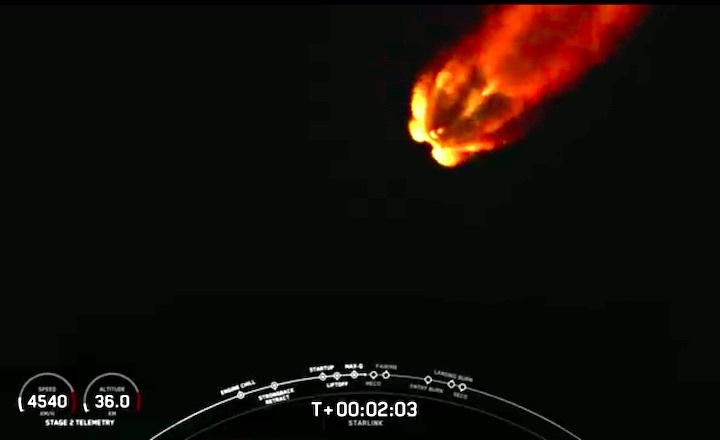
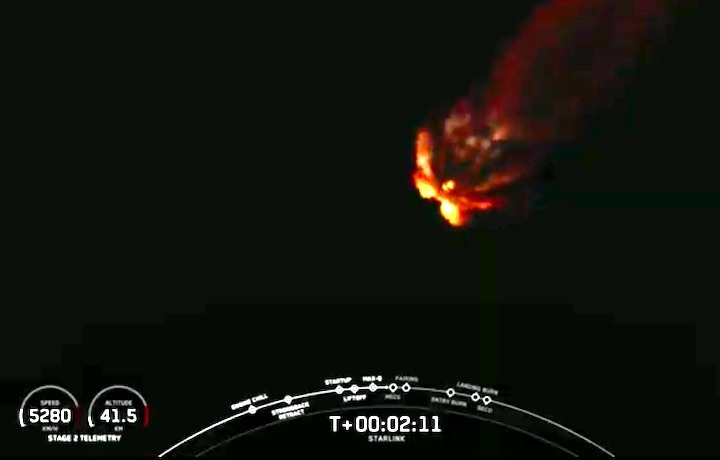
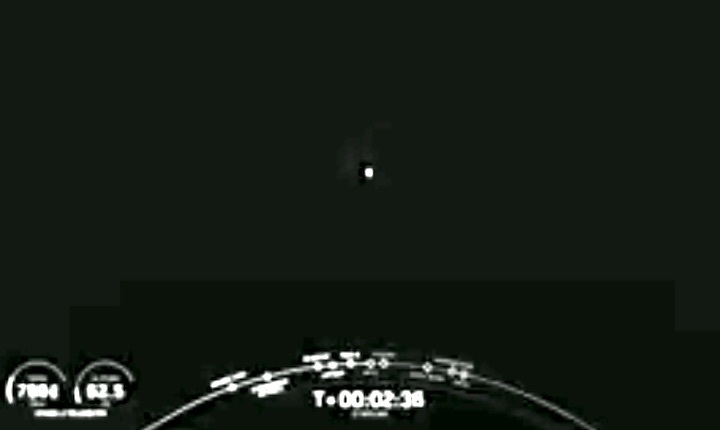
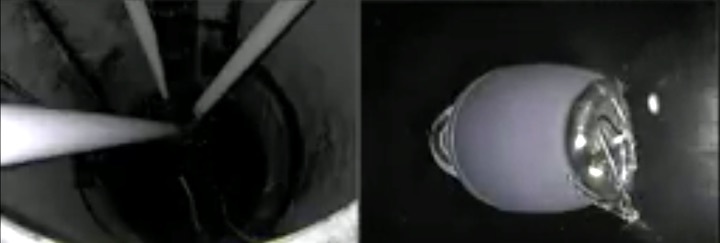
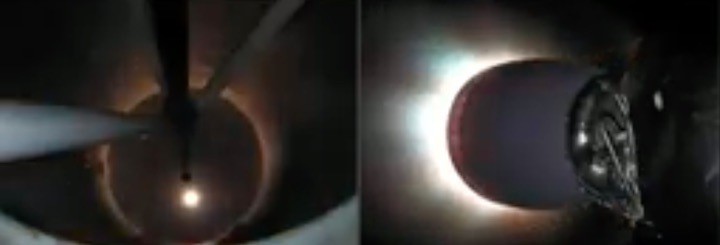
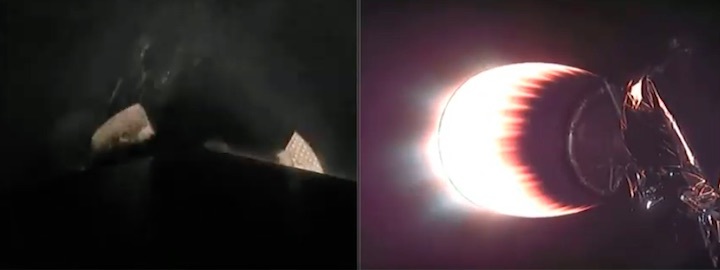
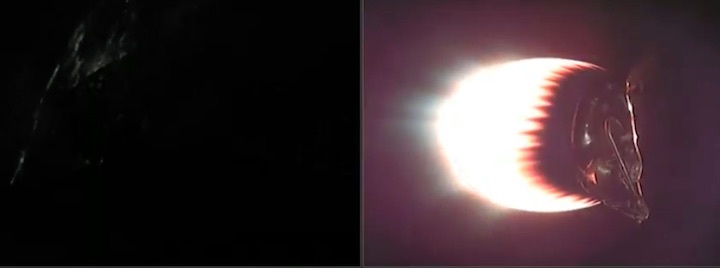
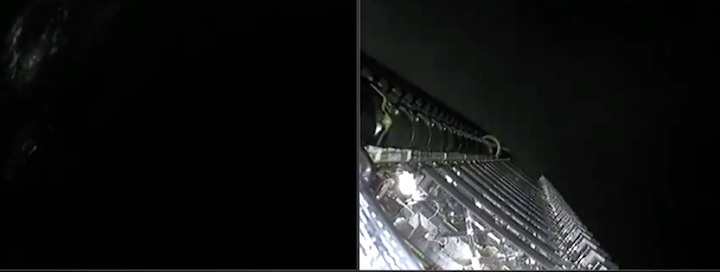
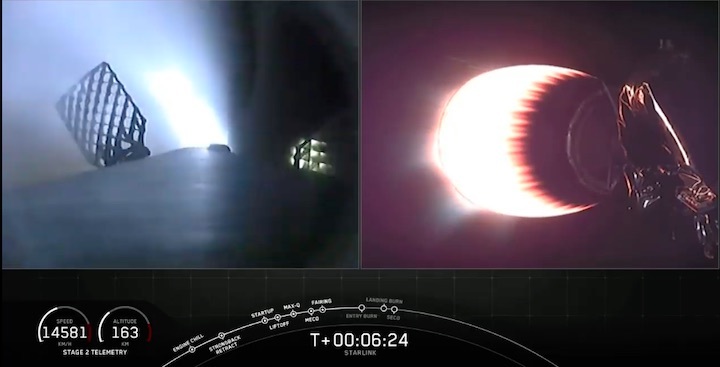
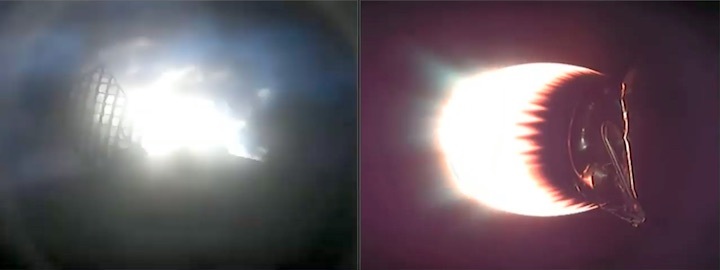
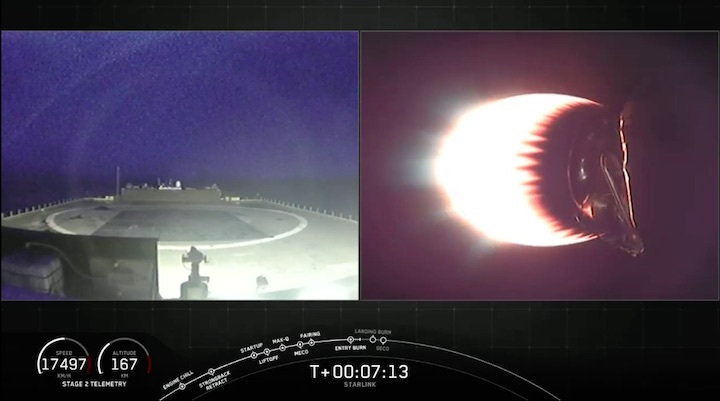
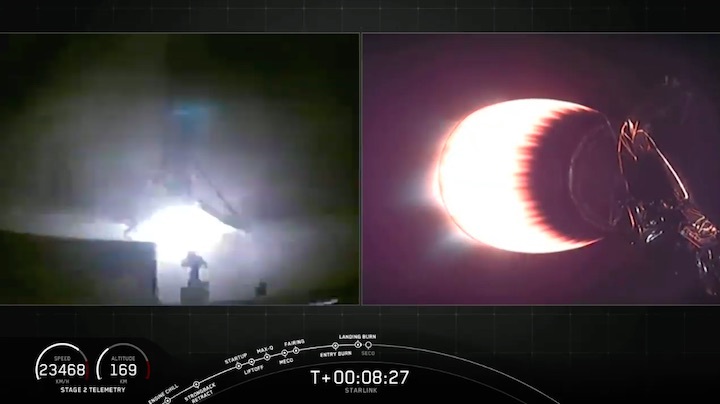
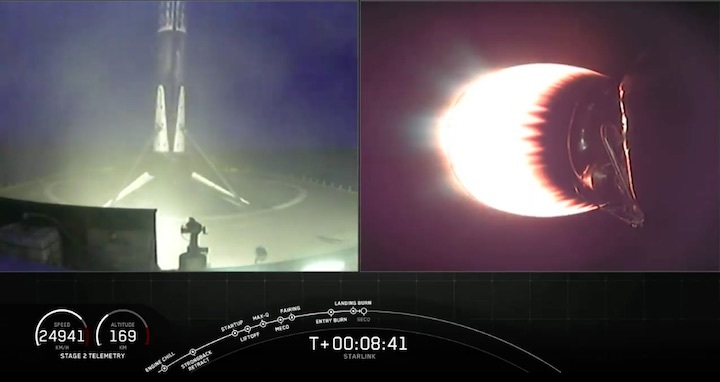
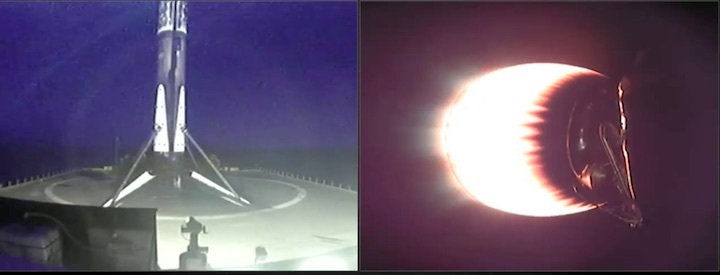
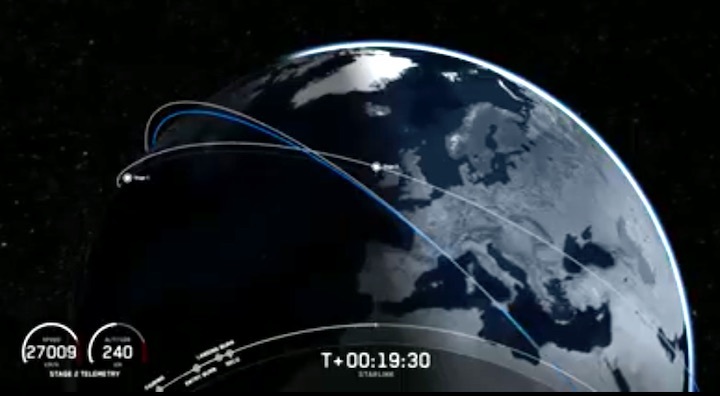
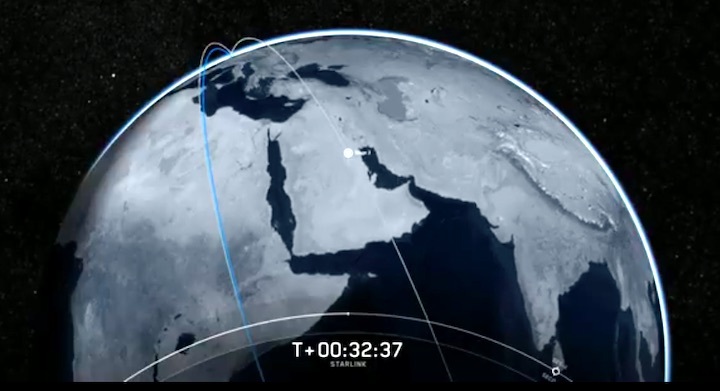
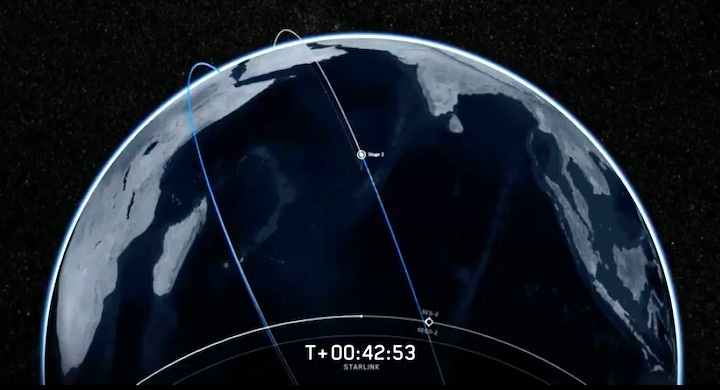
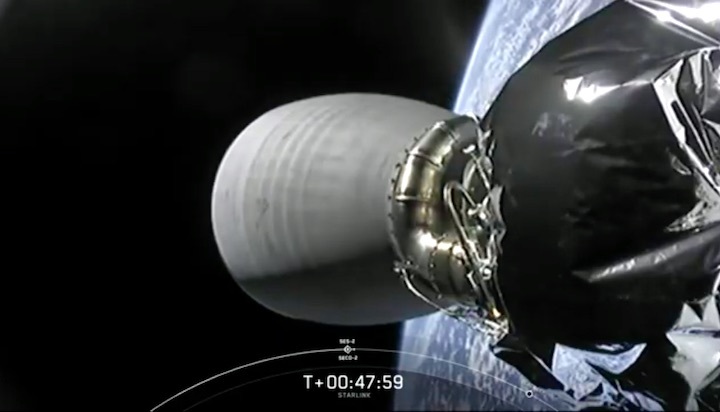
+++
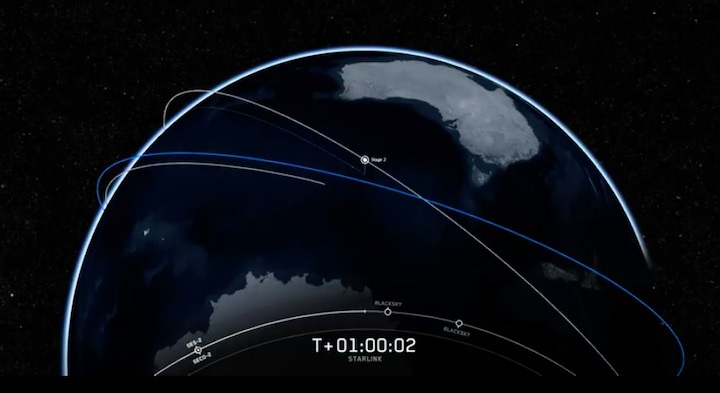
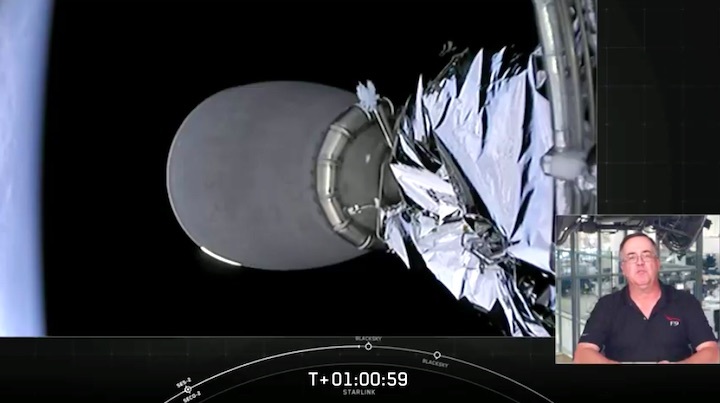
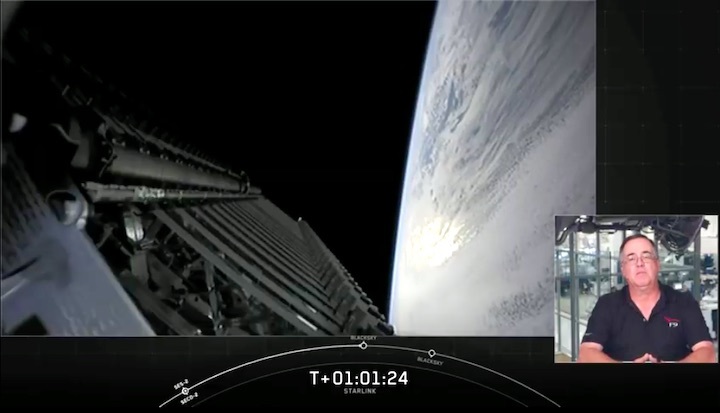
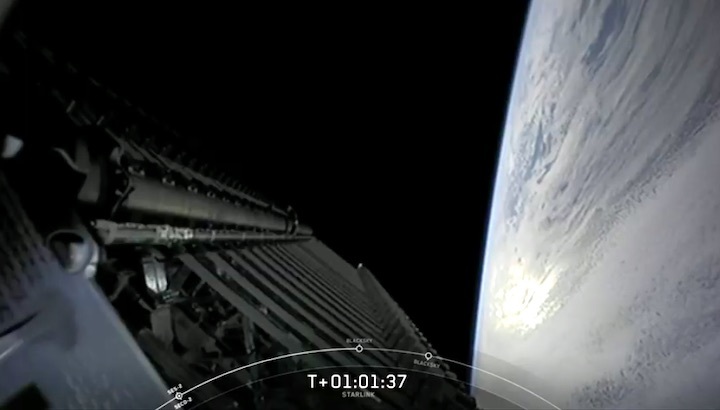
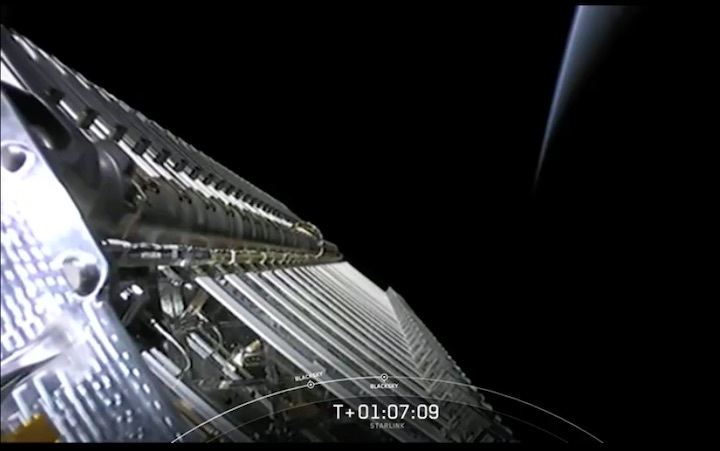
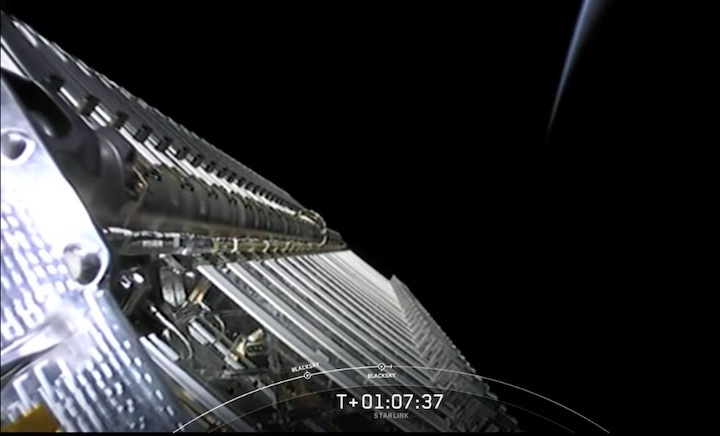
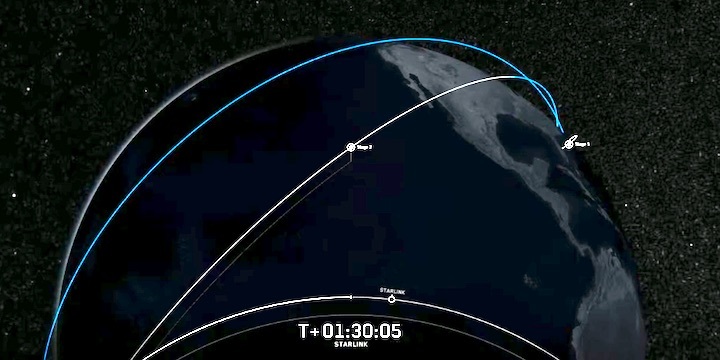
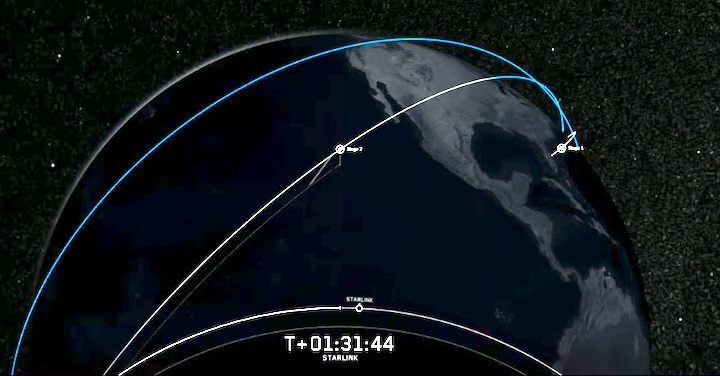
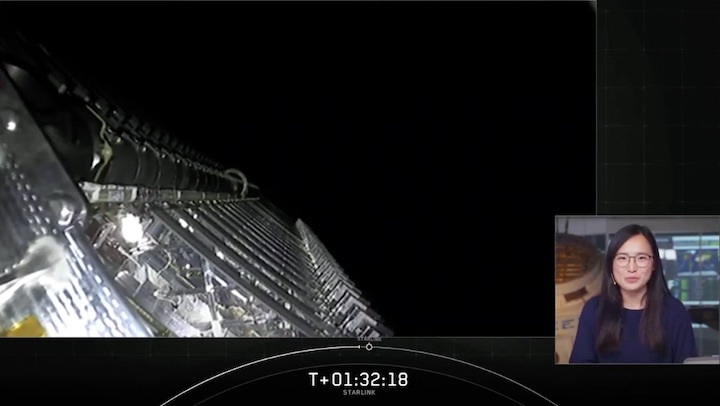
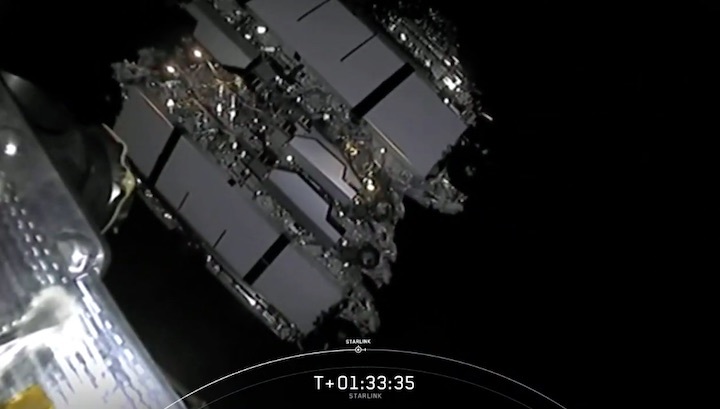
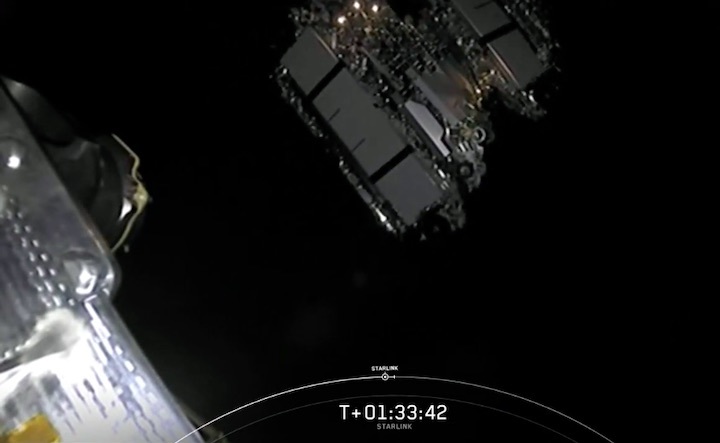
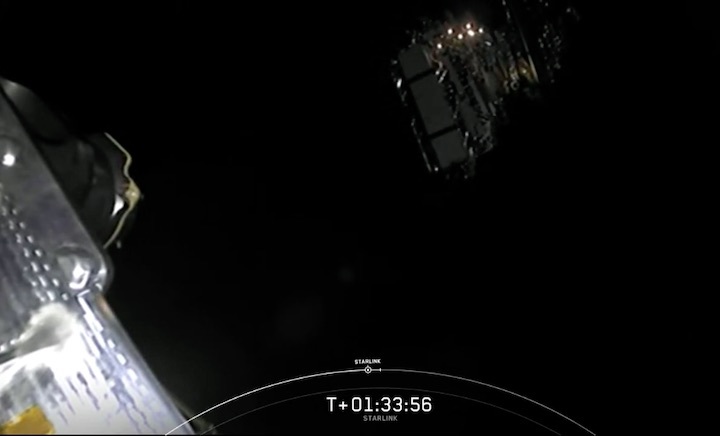
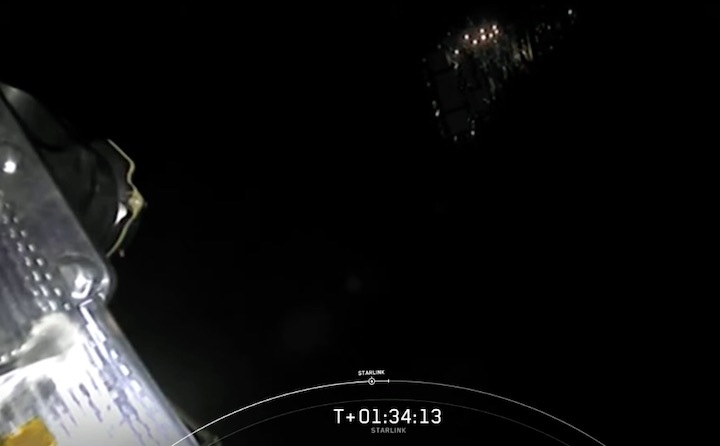
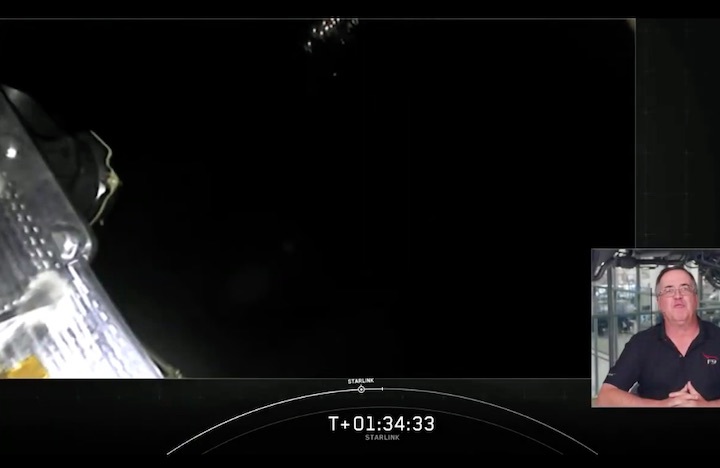
Quelle: SpaceX
